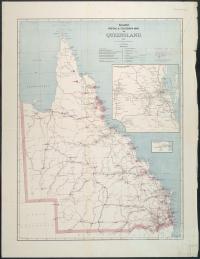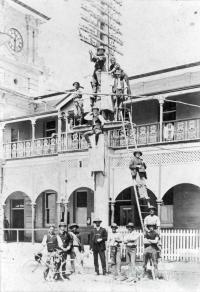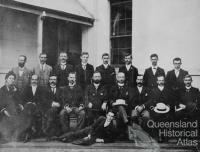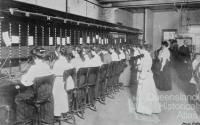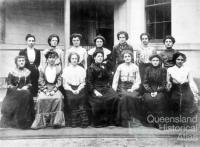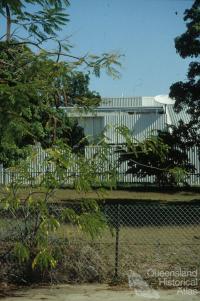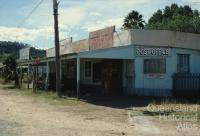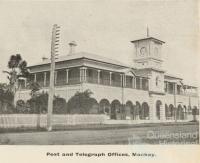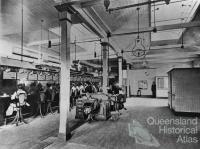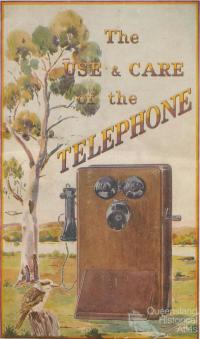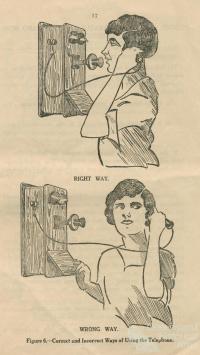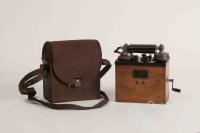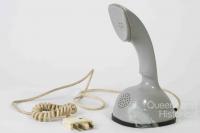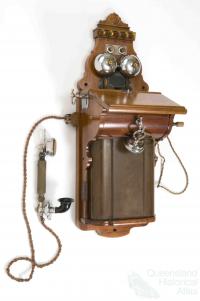- Home
- Quintessential Queensland
- Distinctiveness
- Perceptions
- Perceptions: how people understand the landscape
- From runs to closer settlement
- Geological survey of Queensland
- Mapping a new colony, 1860-80
- Mapping the Torres Strait: from TI to Magani Malu and Zenadh Kes
- Order in Paradise: a colonial gold field
- Queensland atlas, 1865
- Queensland mapping since 1900
- Queensland: the slogan state
- Rainforests of North Queensland
- Walkabout
- Queenslanders
- Queenslanders: people in the landscape
- Aboriginal heroes: episodes in the colonial landscape
- Australian South Sea Islanders
- Cane fields and solidarity in the multiethnic north
- Chinatowns
- Colonial immigration to Queensland
- Greek Cafés in the landscape of Queensland
- Hispanics and human rights in Queensland’s public spaces
- Italians in north Queensland
- Lebanese in rural Queensland
- Queensland clothing
- Queensland for ‘the best kind of population, primary producers’
- Too remote, too primitive and too expensive: Scandinavian settlers in colonial Queensland
- Distance
- Movement
- Movement: how people move through the landscape
- Air travel in Queensland
- Bicycling through Brisbane, 1896
- Cobb & Co
- Journey to Hayman Island, 1938
- Law and story-strings
- Mobile kids: children’s explorations of Cherbourg
- Movable heritage of North Queensland
- Passages to India: military linkages with Queensland
- The Queen in Queensland, 1954
- Transient Chinese in colonial Queensland
- Travelling times by rail
- Pathways
- Pathways: how things move through the landscape and where they are made
- Aboriginal dreaming paths and trading ways
- Chinese traders in the nineteenth century
- Introducing the cane toad
- Pituri bag
- Press and the media
- Radio in Queensland
- Red Cross Society and World War I in Queensland
- The telephone in Queensland
- Where did the trams go?
- ‘A little bit of love for me and a murder for my old man’: the Queensland Bush Book Club
- Movement
- Division
- Separation
- Separation: divisions in the landscape
- Asylums in the landscape
- Brisbane River
- Changing landscape of radicalism
- Civil government boundaries
- Convict Brisbane
- Dividing Queensland - Pauline Hanson’s One Nation Party
- High water mark: the shifting electoral landscape 2001-12
- Hospitals in the landscape
- Indigenous health
- Palm Island
- Secession movements
- Separate spheres: gender and dress codes
- Separating land, separating culture
- Stone walls do a prison make: law on the landscape
- The 1967 Referendum – the State comes together?
- Utopian communities
- Whiteness in the tropics
- Conflict
- Conflict: how people contest the landscape
- A tale of two elections – One Nation and political protest
- Battle of Brisbane – Australian masculinity under threat
- Dangerous spaces - youth politics in Brisbane, 1960s-70s
- Fortress Queensland 1942-45
- Grassy hills: colonial defence and coastal forts
- Great Shearers’ Strike of 1891
- Iwasaki project
- Johannes Bjelke-Petersen: straddling a barbed wire fence
- Mount Etna: Queensland's longest environmental conflict
- Native Police
- Skyrail Cairns (Research notes)
- Staunch but conservative – the trade union movement in Rockhampton
- The Chinese question
- Thomas Wentworth Wills and Cullin-la-ringo Station
- Separation
- Dreaming
- Imagination
- Imagination: how people have imagined Queensland
- Brisbane River and Moreton Bay: Thomas Welsby
- Changing views of the Glasshouse Mountains
- Imagining Queensland in film and television production
- Jacaranda
- Literary mapping of Brisbane in the 1990s
- Looking at Mount Coot-tha
- Mapping the Macqueen farm
- Mapping the mythic: Hugh Sawrey's ‘outback’
- People’s Republic of Woodford
- Poinsettia city: Brisbane’s flower
- The Pineapple Girl
- The writers of Tamborine Mountain
- Vance and Nettie Palmer
- Memory
- Memory: how people remember the landscape
- Anna Wickham: the memory of a moment
- Berajondo and Mill Point: remembering place and landscape
- Cemeteries in the landscape
- Landscapes of memory: Tjapukai Dance Theatre and Laura Festival
- Monuments and memory: T.J. Byrnes and T.J. Ryan
- Out where the dead towns lie
- Queensland in miniature: the Brisbane Exhibition
- Roadside ++++ memorials
- Shipwrecks as graves
- The Dame in the tropics: Nellie Melba
- Tinnenburra
- Vanished heritage
- War memorials
- Curiosity
- Curiosity: knowledge through the landscape
- A playground for science: Great Barrier Reef
- Duboisia hopwoodii: a colonial curiosity
- Great Artesian Basin: water from deeper down
- In search of Landsborough
- James Cook’s hundred days in Queensland
- Mutual curiosity – Aboriginal people and explorers
- Queensland Acclimatisation Society
- Queensland’s own sea monster: a curious tale of loss and regret
- St Lucia: degrees of landscape
- Townsville’s Mount St John Zoo
- Imagination
- Development
- Exploitation
- Transformation
- Transformation: how the landscape has changed and been modified
- Cultivation
- Empire and agribusiness: the Australian Mercantile Land and Finance Company
- Gold
- Kill, cure, or strangle: Atherton Tablelands
- National parks in Queensland
- Pastoralism 1860s–1915
- Prickly pear
- Repurchasing estates: the transformation of Durundur
- Soil
- Sugar
- Sunshine Coast
- The Brigalow
- Walter Reid Cultural Centre, Rockhampton: back again
- Survival
- Survival: how the landscape impacts on people
- Brisbane floods: 1893 to the summer of sorrow
- City of the Damned: how the media embraced the Brisbane floods
- Depression era
- Did Clem Jones save Brisbane from flood?
- Droughts and floods and rail
- Missions and reserves
- Queensland British Food Corporation
- Rockhampton’s great flood of 1918
- Station homesteads
- Tropical cyclones
- Wreck of the Quetta
- Pleasure
- Pleasure: how people enjoy the landscape
- Bushwalking in Queensland
- Cherbourg that’s my home: celebrating landscape through song
- Creating rural attractions
- Festivals
- Queer pleasure: masculinity, male homosexuality and public space
- Railway refreshment rooms
- Regional cinema
- Schoolies week: a festival of misrule
- The sporting landscape
- Visiting the Great Barrier Reef
The telephone provided pathways for people to speak to each other over both short and long distances. Suddenly you could speak to your neighbour a few houses away or communicate with business associates, friends and relatives hundreds or even thousands of kilometres distant.
City exchange
The beginnings of the telephone in Queensland trace back to experiments at the office of the Superintendent of Electric Telegraphs, W.J. Cracknell. On 28 January 1878, only three years after Alexander Graham Bell’s invention in 1875, the first telephone call was made to Ipswich from Cracknell’s Brisbane office, using roughly fashioned phones and 80 km of wire. Over the next two years 36 instruments with single connections were introduced. When the Brisbane exchange opened in June 1880, private firms quickly applied for a connection: entrepreneurs were interested in the fast transmission of information between the different offices and they were happy to fund the new technology. The Edison transmitter combined with the Bell receiver had to be bought by the subscribers for £10 each. They also had to rent the single wire circuits running along streets for £5 per mile and pay a charge of £1 per year for maintenance. Castlemaine Brewery became the first subscriber in Queensland when the offices in Queen Street were connected with the Milton Brewery. The Brisbane Courier office in Queen Street, building material supplier James Campbell and Sons in Creek Street and the Apollo Candle Company in Bulimba followed suit, as well as prominent Brisbane citizens who subscribed for business, financial and prestige reasons, including Edward Robert Drury, the general manager of the Queensland National Bank, and Sir Thomas McIlwraith, then Premier of Queensland.
The Brisbane exchange had a major influence on the spread of telephony in Queensland, being among the first manual exchanges in Australia, together with those opened in Sydney and Melbourne in the same year. Demand quickly grew and the Brisbane Central Exchange started a continuous service in April 1883, by which time 175 subscribers were already connected, although not all clients would have been satisfied with the telephone service. It was slow and expensive so that most people still preferred post and telegraph. Nevertheless the telephone spread rapidly in the city and by 1885 the exchange handled more than 300 subscribers. By 1927, 200 telephonists operated the Common Battery Manual Exchange at the General Post Office Brisbane and on 30 November 1929 the automatic telephone exchange was finally brought in operation in Queensland, more than 17 years after the first automatic exchange in Melbourne.
Rural Queensland
While the demand for telecommunications was growing in the cities, especially for business purposes, people in the country were rarely able to afford the high charges. The operation of an exchange in Queensland was much more expensive than for those further south due to both the long distances and the smaller number of subscribers. Nevertheless, by the beginning of the twentieth century telephone lines had extended into rural areas. The first country exchange in Australia opened at Maryborough, Queensland in 1882, 32 subscribers set for the exchange. This was the first opportunity for a rural area in Australia to gain access to technology that overcame distance through the transmisssion of speech. The technology quickly spread north especially in the rapidly growing ports. A country exchange was opened at Townsville in November 1883, Rockhampton followed in 1884, Bundaberg in 1886 and Charters Towers in 1891. However, it was not until John Hesketh, Chief Electrical Engineer for the Queensland Post and Telegraph Department reduced the telephone rates dramatically, in order to popularise the service, that the telephone network began to spread rapidly in the rural areas. At the turn of the century the number of country exchanges had doubled and by 1910 the number had risen to 58 exchanges.
Many of the pastoral areas of Queensland gained access to the new communications system with the help of private lines. These were fairly long lines using trees, fences and the occasional pole to carry the telephone lines. Small networks were set up between stations (for example, in the Longreach district around 30 stations were connected). The telephone system worked through the local exchanges and by trunkline with adjoining towns. With the introduction of the phonophore system, the telephone network was then able to use the proliferation of telegraph wires already in place. Networking at the beginning of the twentieth century saw telegraph wires spread out from regional centres to relatively isolated farms. The creation of the Postmaster General’s Department (PMG) in 1901 put the onus on the new Commonwealth Government to expand the reach of telephony.
War time communication
During World War II, General MacArthur, Commander-In-Chief of the Allied Forces for the Southwest Pacific, set up General Headquarters in the then AMP Building in Queen Street, Brisbane. Telephone communication in wartime had to be secure and the telephone exchange was set up in the basement of the building was one of only 12 exchanges in the world that had scramble technique for security and became known as ‘Bataan’ Exchange. The Sigsaly terminal weighed over 50 tons and was operated by thirteen signalers.
Copper wire
Many rural areas of Queensland remained isolated with manual exchanges continuing well into the second half of the twentieth century. However, by the end of the twentieth century, over one million Queenslander households were connected by copper wire.
The breakup of the PMG into Australia Post and Telecom in 1975 foreshadowed growing deregulation of telephony, furthered by the public floats of shares in Telstra and the rise of Optus as another major carrier. While mobile phones reach over 98 per cent of Queenslanders they only cover about a fifth of the State’s landmass.

